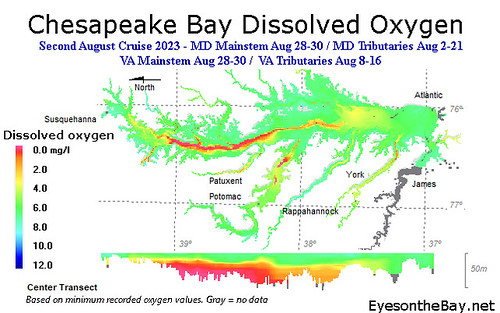Chesapeake Bay Hypoxia Report – August 2023
Early August dissolved oxygen conditions best on record for time period
 Data collected by the Maryland Department of Natural Resources and Old Dominion University show that August 2023 dissolved oxygen conditions in the Chesapeake Bay mainstem of Maryland and Virginia continued to be much better than average.
Data collected by the Maryland Department of Natural Resources and Old Dominion University show that August 2023 dissolved oxygen conditions in the Chesapeake Bay mainstem of Maryland and Virginia continued to be much better than average.
The results are from samples collected during regular, twice-monthly monitoring cruises conducted by research vessels. Throughout the summer, the cruises have recorded hypoxic areas of the Bay – water with low enough dissolved oxygen to harm marine life – that have been smaller than those recorded in previous years.
 The hypoxic water volume — waters with less than 2 mg/l oxygen — was 0.31 and 0.72 cubic miles respectively during the early and late August monitoring cruises, compared to early and late August averages of 1.37 and 1.076 cubic miles since 1985.
The hypoxic water volume — waters with less than 2 mg/l oxygen — was 0.31 and 0.72 cubic miles respectively during the early and late August monitoring cruises, compared to early and late August averages of 1.37 and 1.076 cubic miles since 1985.
 This year’s data from early August ranks as the smallest volume of hypoxic water volume on record and late August was the eighth smallest volume for their respective time periods. Small volumes of anoxia – areas of water with less than 0.2 mg/l oxygen – were observed in the early (0.09 cubic miles) and late August (0.009 cubic miles) monitoring cruises.
This year’s data from early August ranks as the smallest volume of hypoxic water volume on record and late August was the eighth smallest volume for their respective time periods. Small volumes of anoxia – areas of water with less than 0.2 mg/l oxygen – were observed in the early (0.09 cubic miles) and late August (0.009 cubic miles) monitoring cruises.
Maryland and Virginia combined results are comparable to the yearly seasonal forecast by the U.S. Environmental Protection Agency’s Chesapeake Bay Program, U.S. Geological Survey, University of Maryland Center for Environmental Science, and University of Michigan.
In late June, this forecast expected Chesapeake Bay mainstem hypoxic volume to be 33% lower than the 38-year average, due to reduced river flows from January through May 2023, as well as less nitrogen carried to the Bay because of nutrient management efforts. Maryland and Virginia’s monitoring results thus far have matched the forecast of better-than-average conditions.
Crabs, fish, oysters, and other creatures in the Chesapeake Bay require oxygen to survive. Scientists and natural resource managers study the volume and duration of Bay hypoxia to determine possible impacts to bay life.
Ongoing efforts to reduce nitrogen and phosphorus pollution from industrial sources, agricultural land, and cities and towns are aimed at reducing hypoxic conditions in the Bay. In the water, nitrogen and phosphorus fuel algal blooms that remove oxygen from the water when they die off.
Each year from May through October, the Department of Natural Resources computes hypoxia volumes from the water quality data collected by department staff and the Virginia Department of Environmental Quality. Data collection is funded by these states and the Chesapeake Bay Program. Bay hypoxia monitoring and reporting will continue through the summer. Additional Maryland water quality data and information, including the Department of Natural Resources hypoxic volume calculation methods, can be found on the Eyes on the Bay website.
